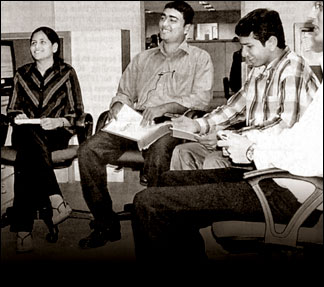Brainstorming and creative problem solving
Management Tips:
Dr. K. Kuhathasan CEO Cenlead
Brainstorming is probably the best known of all the techniques
available for creative problem solving.
 Linus Pauling, the Nobel Prize-winning scientist once said: "The best
way to get good ideas is to have lot of ideas. That is as true for a
team or an organisation as it is for an individual. But how do you
facilitate this productivity of ideas as a manager? Linus Pauling, the Nobel Prize-winning scientist once said: "The best
way to get good ideas is to have lot of ideas. That is as true for a
team or an organisation as it is for an individual. But how do you
facilitate this productivity of ideas as a manager?
Brainstorming has been defined as a method of getting a large number
of ideas from a group of people in a short time. It is essentially a
group activity which follows a relatively formal procedure to generate
as many ideas as possible.
Brainstorming is a key part in quality circles and total quality
management programmes. Almost always these programmes, introduced to
improve quality of products or services, hinge on small groups or teams
questing for new ideas, both on product improvements and issues of
efficiency, such as reducing costs.
Mind game
Brainstorming is a mind game and it is a useful technique for
releasing ideas by overcoming inhibitions, cross-fertilising minds and
getting away from fixed rules or hidden assumptions.
It needs to be prepared and planned, and followed up with evaluation.
The principle that distinguishes brainstorming from just getting
together and talking is that the session begins with a stage in which
anything goes. All ideas are allowed a chance.
This ensures that contributors aren't as apt to feel inhibited about
saying something stupid. What's more, the growing list of ideas will
help to trigger new and better ones.
You can apply the brainstorming technique to your individual efforts
also allow your ideas to reach a piece of paper, without judging them.
Include ridiculous-sounding ideas too, because they may set off a new
and better line of thinking.
Visit your unconscious mind
You can also help yourself to be more creative by giving your
imagination occasional workouts. This may mean nothing more than
encouraging your mind to produce imaginary movies, and then playing with
the images until they become available as sources for your work -
whether that be a painting or problems on the job or in daily life.
It is said that Einstein hit upon the theory of relativity while
imagining himself flying along at the speed of light. Another
often-stated example of the practical power of imagery is that of the
German chemist Kekule, who happened to be dreaming when he discovered
that he molecules of benzene are arranged.
Preparation
Today, the most popular group creativity technique is brainstorming.
Although it is widely practiced, it is seldom used correctly for optimum
benefit. Even if you currently use brainstorming, review these rules to
check your technique.
Prior to the meeting, give each participant an overview of the
subject to be brainstormed: The problem statement, background
information, etc.
Brainstorming Rules:
The ideal group size is between 5 and 12 people. Ideally all are
familiar with the procedure.
A facilitator will lead the group, a recorder will write a record of
the ideas expressed (usually on chalkboard or filip chart for the
participants to see and review).
A timer will also help keep the group moving. The entire group should
participate in the idea-generating process.
Before working on the problem situation, it is a good idea to begin
with a warm up exercise to relax and loosen up the group. When you are
ready to "get to work" the facilitator state the problem and invites
input.
Facilitators should:
1. Keep the atmosphere relaxed, fun, and freewheeling.
2. Encourage everyone to participate either with original ideas, or
"pig-gybacking" (adding on to) other people's input.
3. Focus initially on quantity, not quality for ideas. Some groups
set a numerical goal (for example, 25 or 50 ideas) and try to reach it
in the allotted time.
4. urge participants to say anything that occurs to them, no matter
how wild or "far out" those ideas may seem.
5. Allow appropriate time (20 to 30 minutes) for the idea generation
phase.
If the group has been too conservative during this part of the
session, the facilitator might want to use the final five minutes and
ask, "What are the wildest, most outrageous ideas we can come up with?"
(Remember, you may find a gem of an idea that could be altered to fit
reality!)
6. Stay alert for nonproductive comments such as, "We tried that last
year," "That would cost too much," "I don't think that will work," "This
isn't the time of evaluation yet." judge, criticise, or squelch any of
the ideas generated.
Evaluation
Evaluation is the hardest and most demanding part of a brainstorming
session. It can be time consuming, and give some disillusionment to the
process, especially when nothing seems to be happening with the ideas
produced.
The three stages of quick scrutiny, evaluation by all participants
and evaluation by a team should always be used.
Evaluation may be best done not by the brainstorming group itself but
by a small group of five members directly concerned with the problem.
Keep the brainstorming group informed of the result, otherwise they
may want to be excused the next time they are asked! The steps of
evaluation are:
1. Decide on appropriate criteria.
2. Pick out instant winners.
3. Eliminate the unwanted or inappropriate.
4. Sort similar ideas into groups and select best of each group.
5. Apply criteria to instant winners and best of each group. |

